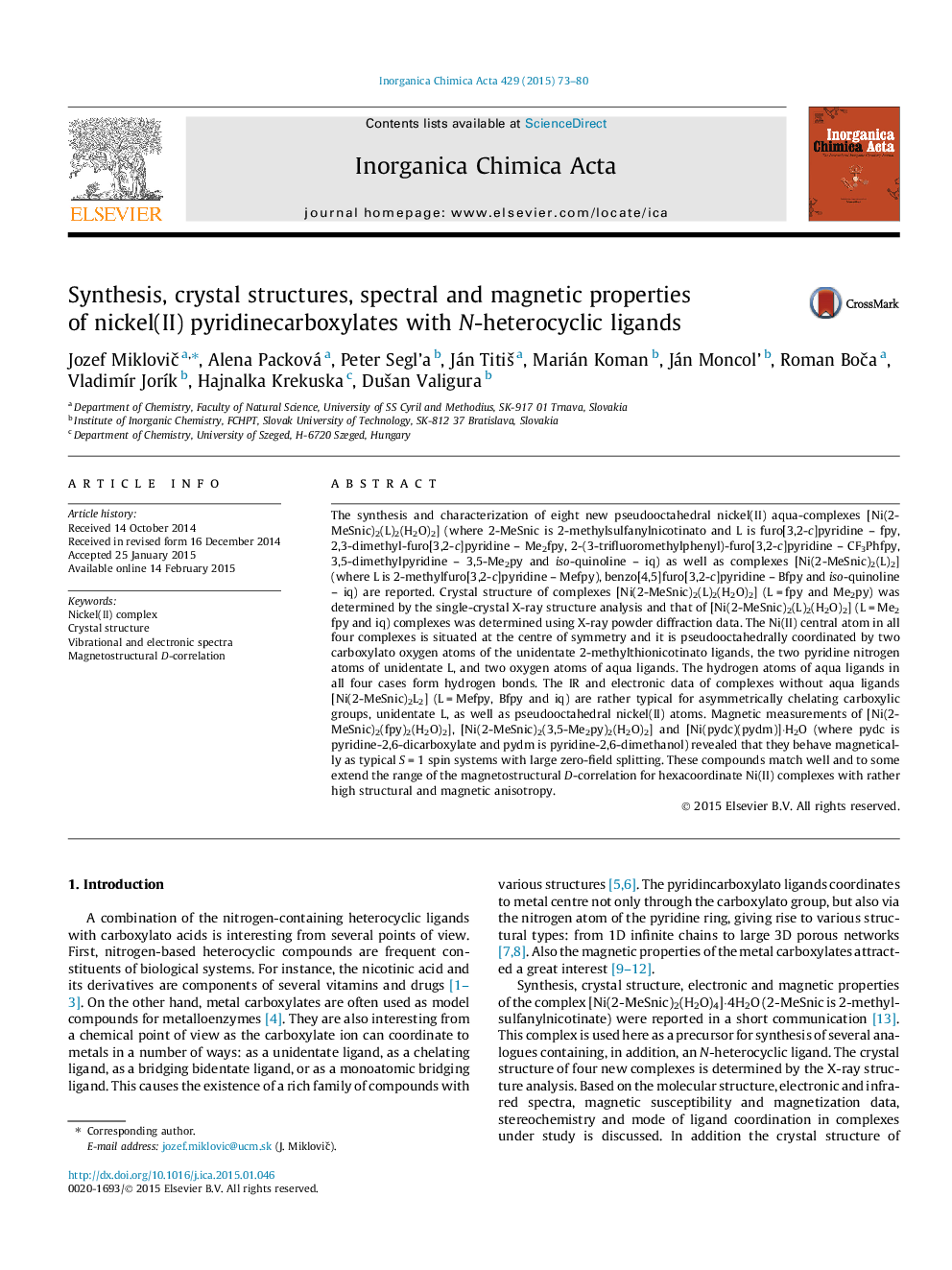| Article ID | Journal | Published Year | Pages | File Type |
|---|---|---|---|---|
| 1306609 | Inorganica Chimica Acta | 2015 | 8 Pages |
•Eight new 2-methylsulfanylnicotinatonickel(II) complexes prepared and characterized.•X-ray diffraction and structure description of four new pseudooctahedral complexes.•Magnetic properties of three complexes determined.•Increased magnetic anisotropy correlated with structural distortion of chromophore.
The synthesis and characterization of eight new pseudooctahedral nickel(II) aqua-complexes [Ni(2-MeSnic)2(L)2(H2O)2] (where 2-MeSnic is 2-methylsulfanylnicotinato and L is furo[3,2-c]pyridine – fpy, 2,3-dimethyl-furo[3,2-c]pyridine – Me2fpy, 2-(3-trifluoromethylphenyl)-furo[3,2-c]pyridine – CF3Phfpy, 3,5-dimethylpyridine – 3,5-Me2py and iso-quinoline – iq) as well as complexes [Ni(2-MeSnic)2(L)2] (where L is 2-methylfuro[3,2-c]pyridine – Mefpy), benzo[4,5]furo[3,2-c]pyridine – Bfpy and iso-quinoline – iq) are reported. Crystal structure of complexes [Ni(2-MeSnic)2(L)2(H2O)2] (L = fpy and Me2py) was determined by the single-crystal X-ray structure analysis and that of [Ni(2-MeSnic)2(L)2(H2O)2] (L = Me2fpy and iq) complexes was determined using X-ray powder diffraction data. The Ni(II) central atom in all four complexes is situated at the centre of symmetry and it is pseudooctahedrally coordinated by two carboxylato oxygen atoms of the unidentate 2-methylthionicotinato ligands, the two pyridine nitrogen atoms of unidentate L, and two oxygen atoms of aqua ligands. The hydrogen atoms of aqua ligands in all four cases form hydrogen bonds. The IR and electronic data of complexes without aqua ligands [Ni(2-MeSnic)2L2] (L = Mefpy, Bfpy and iq) are rather typical for asymmetrically chelating carboxylic groups, unidentate L, as well as pseudooctahedral nickel(II) atoms. Magnetic measurements of [Ni(2-MeSnic)2(fpy)2(H2O)2], [Ni(2-MeSnic)2(3,5-Me2py)2(H2O)2] and [Ni(pydc)(pydm)]·H2O (where pydc is pyridine-2,6-dicarboxylate and pydm is pyridine-2,6-dimethanol) revealed that they behave magnetically as typical S = 1 spin systems with large zero-field splitting. These compounds match well and to some extend the range of the magnetostructural D-correlation for hexacoordinate Ni(II) complexes with rather high structural and magnetic anisotropy.
Graphical abstractFive new pseudooctahedral nickel(II) complexes have been prepared, structurally and magnetically characterized. For three complexes the zero-field splitting parameter D has been extracted from SQUID measurements and correlated with the structural tetragonality parameter Dstr. These complexes span the prediction interval of the previously published correlations and confirm the assumption that the negative ZFS parameter D of the Ni(II) can be tuned by the tetragonal compression of the pseudooctahedral chromophore.Figure optionsDownload full-size imageDownload as PowerPoint slide
